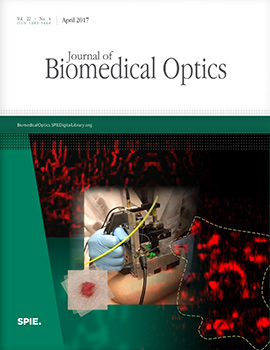Joana Balardin, Guilherme Zimeo Morais, Rogério Furucho, Lucas Trambaiolli, João Sato
Journal of Biomedical Optics, Vol. 22, Issue 04, 046010, (April 2017) https://doi.org/10.1117/1.JBO.22.4.046010

TOPICS: Head, Near infrared spectroscopy, Hemodynamics, Signal to noise ratio, Sensors, Optical communications, Motion analysis, Chest, Signal detection, Brain
Functional near-infrared spectroscopy (fNIRS) is currently one of the most promising tools in the neuroscientific research to study brain hemodynamics during naturalistic social communication. The application of fNIRS by studies in this field of knowledge has been widely justified by its strong resilience to motion artifacts, including those that might be generated by communicative head and facial movements. Previous studies have focused on the identification and correction of these artifacts, but a quantification of the differential contribution of common communicative movements on the quality of fNIRS signals is still missing. We assessed the impact of four movements (nodding head up and down, reading aloud, nodding head sideways, and raising eyebrows) performed during rest and task conditions on two metrics of signal quality control: an estimative of signal-to-noise performance and the negative correlation between oxygenated and deoxygenated hemoglobin (oxy-Hb and deoxy-Hb). Channel-wise group analysis confirmed the robustness of the fNIRS technique to head nodding movements but showed a large effect of raising eyebrows in both signal quality control metrics, both during task and rest conditions. Reading aloud did not disrupt the expected anticorrelation between oxy-Hb and deoxy-Hb but had a relatively large effect on signal-to-noise performance. These findings may have implications to the interpretation of fNIRS studies examining communicative processes.



 Receive Email Alerts
Receive Email Alerts